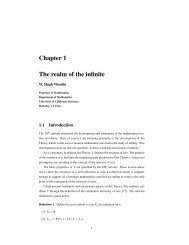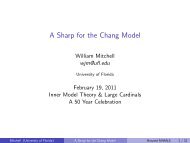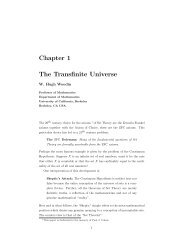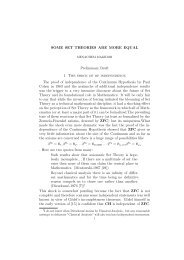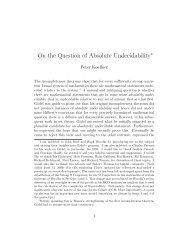The Continuum Hypothesis - Logic at Harvard
The Continuum Hypothesis - Logic at Harvard
The Continuum Hypothesis - Logic at Harvard
You also want an ePaper? Increase the reach of your titles
YUMPU automatically turns print PDFs into web optimized ePapers that Google loves.
So the trouble is with (A).This illustr<strong>at</strong>es an interesting contrast between our three versions of theeffective continuum hypothesis, namely, th<strong>at</strong> they can come apart. For whilelarge cardinals rule out definable counterexamples of the first two kinds, theycannot rule out definable counterexamples of the third kind. But again wemust stress th<strong>at</strong> they cannot prove th<strong>at</strong> there are such counterexamples.But there is animportant point: Assuming largecardinal axioms (AD L(R)suffices), although one can produce outer models in which δ ∼13 > ℵ 2 it is notcurrently known how to produce outer models in which δ ∼13 > ℵ 3 or evenΘ L(R) > ℵ 3 . Thus it is an open possibility th<strong>at</strong> from ZFC+AD L(R) one canprove Θ L(R) ℵ 3 . Were this to be the case, it would follow th<strong>at</strong> althoughlarge cardinals cannot rule out the definable failure of CH they can rule outthe definable failure of 2 ℵ 0= ℵ 2 . This could provide some insight into thesize of the continuum, underscoring the centrality of ℵ 2 .Further Reading: For more on the three effective versions of CH see Martin(1976); for more on the Foreman-Magidor program see Foreman & Magidor(1995) and the introduction to Woodin (1999).3 <strong>The</strong> Case for ¬CH<strong>The</strong> above results led Woodin to the identific<strong>at</strong>ion of a “canonical” modelin which CH fails and this formed the basis of his an argument th<strong>at</strong> CH isfalse. In Section 3.1 we will describe the model and in the remainder of thesection we will present the case for the failure of CH. In Section 3.2 we willintroduce Ω-logic and the other notions needed to make the case. In Section3.3 we will present the case.3.1 P max<strong>The</strong> goal is to find a model in which CH is false and which is canonical in thesense th<strong>at</strong> its theory cannot be altered by set forcing in the presence of largecardinals. <strong>The</strong> background motiv<strong>at</strong>ion is this: First, we know th<strong>at</strong> in thepresence of large cardinal axioms the theory of second-order arithmetic andeven the entire theory of L(R) is invariant under set forcing. <strong>The</strong> importanceof this is th<strong>at</strong> it demonstr<strong>at</strong>es th<strong>at</strong> our main independence techniques cannotbe used to establish the independence of questions about second-order12





